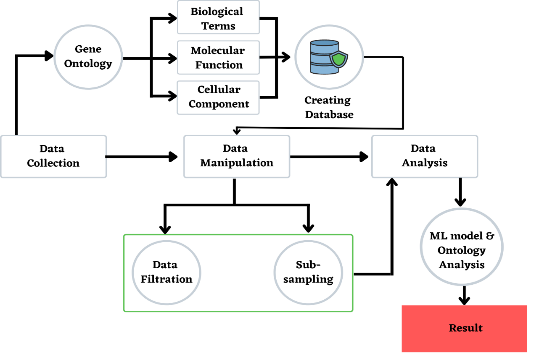Prediction Evaluation of Gene Ontology Using Support Vector Machine
Main Article Content
Abstract
The present state of sequenced programs requires the assignment of gene product functions in a timely, accurate and trustworthy manner. Many approaches to large-scale label designs have been developed. On the other hand, these approaches can only be used on a limited number of sub-sets. Their conclusions are not formalized. On the other hand, such approaches can only be used on a limited number of subsets, as their conclusions are not standardized. Annotation was supplied using Gene Ontology (GO) or categorization of valid or incorrect prediction using Support Vector Machines (SVM). A large database was used to assess the system's overall effectiveness. Reliability prediction was cross-validated organization by organization, yielding an average accuracy of 74% of all test cycles and 80%. The verification results revealed that the predictive efficacy was not dependent on the micro-organism because it could duplicate the high-quality automatic manual annotation. We used our trained categorization method to annotate Xenopuslaevis sequences, and greater than half of the known expressed genome was functionally annotated. We gave more than double the number of contigs with excellent annotations of high brightness compared to the already accessible annotations, and we also allocated a confidence score to each anticipated Gene Ontology (GO).
Article Details
References
G. Eason, B. Noble, and I. N. Sneddon, “On certain integrals of Lipschitz-Hankel type involving products of Bessel functions,” Phil. Trans. Roy. Soc. London, vol. A247, pp. 529–551, April 1955. (references)
J. Clerk Maxwell, A Treatise on Electricity and Magnetism, 3rd ed., vol. 2. Oxford: Clarendon, 1892, pp.68–73.
I. S. Jacobs and C. P. Bean, “Fine particles, thin films and exchange anisotropy,” in Magnetism, vol. III, G. T. Rado and H. Suhl, Eds. New York: Academic, 1963, pp. 271–350.
Jajam, N. ., & Challa, N. P. . (2023). Customer Churn Detection for insurance data using Blended Logistic Regression Decision Tree Algorithm (BLRDT). International Journal of Intelligent Systems and Applications in Engineering, 11(1s), 72–83. Retrieved from https://ijisae.org/index.php/IJISAE/article/view/2479.
K. Elissa, “Title of paper if known,” unpublished.
R. Nicole, “Title of paper with only first word capitalized,” J. Name Stand. Abbrev., in press.
Kevin Harris, Lee Green, Juan González, Juan Garciam, Carlos Rodríguez. Automated Content Generation for Personalized Learning using Machine Learning. Kuwait Journal of Machine Learning, 2(2). Retrieved from http://kuwaitjournals.com/index.php/kjml/article/view/180.
Y. Yorozu, M. Hirano, K. Oka, and Y. Tagawa, “Electron spectroscopy studies on magneto-optical media and plastic substrate interface,” IEEE Transl. J. Magn. Japan, vol. 2, pp. 740–741, August 1987 [Digests 9th Annual Conf. Magnetics Japan, p. 301, 1982].
M. Young, The Technical Writer’s Handbook. Mill Valley, CA: University Science, 1989.
Electronic Publication: Digital Object Identifiers (DOIs):
Article in a journal:
D. Kornack and P. Rakic, “Cell Proliferation without Neurogenesis in Adult Primate Neocortex,” Science, vol. 294, Dec. 2001, pp. 2127-2130, doi:10.1126/science.1065467.
Chang Lee, Deep Learning for Speech Recognition in Intelligent Assistants , Machine Learning Applications Conference Proceedings, Vol 1 2021.
Article in a conference proceedings:
H. Goto, Y. Hasegawa, and M. Tanaka, “Efficient Scheduling Focusing on the Duality of MPL Representatives,” Proc. IEEE Symp. Computational Intelligence in Scheduling (SCIS 07), IEEE Press, Dec. 2007, pp. 57-64, doi:10.1109/SCIS.2007.357670.
Goar, D. V. . (2021). Biometric Image Analysis in Enhancing Security Based on Cloud IOT Module in Classification Using Deep Learning- Techniques. Research Journal of Computer Systems and Engineering, 2(1), 01:05. Retrieved from https://technicaljournals.org/RJCSE/index.php/journal/article/view/9.
Kshirsagar, P. R., Yadav, R. K., Patil, N. N., & Makarand L, M. (2022). Intrusion Detection System Attack Detection and Classification Model with Feed-Forward LSTM Gate in Conventional Dataset. Machine Learning Applications in Engineering Education and Management, 2(1), 20–29. Retrieved from http://yashikajournals.com/index.php/mlaeem/article/view/21.
Y. MohanaRoopa,et.al,” Estimation of Spacecraft Telemetry Faults using SVM &K-Means MachineLearning Algorithms: TELEMATIQUE,, ISSN: 1856-4194 (Online),Volume 21 Issue 1, 2022,Page No2035 - 2044

